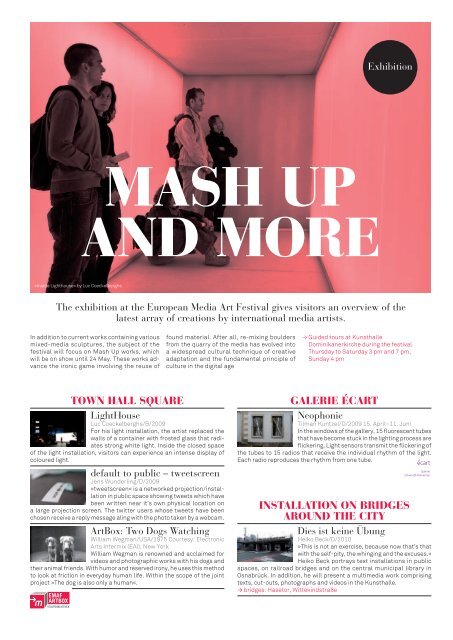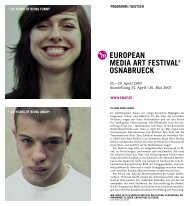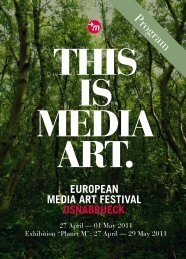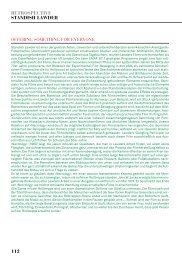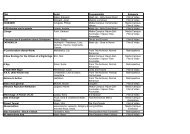Download: Festival Guide - Emaf
Download: Festival Guide - Emaf
Download: Festival Guide - Emaf
Create successful ePaper yourself
Turn your PDF publications into a flip-book with our unique Google optimized e-Paper software.
»Inside Lighthouse« by Luc Coeckelberghs<br />
masH up<br />
anD mOre<br />
The exhibition at the European Media Art <strong>Festival</strong> gives visitors an overview of the<br />
latest array of creations by international media artists.<br />
In addition to current works containing various<br />
mixed-media sculptures, the subject of the<br />
festival will focus on Mash Up works, which<br />
will be on show until 24 May. These works advance<br />
the ironic game involving the reuse of<br />
tOWn Hall sQuare<br />
LightHouse<br />
Luc Coeckelberghs/B/2009<br />
For his light installation, the artist replaced the<br />
walls of a container with frosted glass that radiates<br />
strong white light. Inside the closed space<br />
of the light installation, visitors can experience an intense display of<br />
coloured light.<br />
default to public – tweetscreen<br />
Jens Wunderling/D/2009<br />
»tweetscreen« is a networked projection/installation<br />
in public space showing tweets which have<br />
been written near it’s own physical location on<br />
a large projection screen. The twitter users whose tweets have been<br />
chosen receive a reply message aling with the photo taken by a webcam.<br />
ArtBox: Two Dogs Watching<br />
William Wegman/USA/1975 Courtesy: Electronic<br />
Arts Intermix (EAI), New York<br />
William Wegman is renowned and acclaimed for<br />
videos and photographic works with his dogs and<br />
their animal friends. With humor and reserved irony, he uses this method<br />
to look at friction in everyday human life. Within the scope of the joint<br />
project »The dog is also only a human«.<br />
found material. After all, re-mixing boulders<br />
from the quarry of the media has evolved into<br />
a widespread cultural technique of creative<br />
adaptation and the fundamental principle of<br />
culture in the digital age<br />
≥ <strong>Guide</strong>d tours at Kunsthalle<br />
Dominikanerkirche during the festival<br />
Thursday to Saturday 3 pm and 7 pm,<br />
Sunday 4 pm<br />
galerIe éCart<br />
Exhibition<br />
Neophonie<br />
Tilman Küntzel/D/2009 15. April–11. Juni<br />
In the windows of the gallery, 15 fluorescent tubes<br />
that have become stuck in the lighting process are<br />
flickering. Light sensors transmit the flickering of<br />
the tubes to 15 radios that receive the individual rhythm of the light.<br />
Each radio reproduces the rhythm from one tube.<br />
ecart<br />
InstallatIOn On BrIDges<br />
arOunD tHe CItY<br />
Galerie<br />
Schwindt-Kleveman<br />
Dies ist keine Übung<br />
Heiko Beck/D/2010<br />
»This is not an exercise, because now that’s that<br />
with the self-pity, the whinging and the excuses.«<br />
Heiko Beck portrays text installations in public<br />
spaces, on railroad bridges and on the central municipal library in<br />
Osnabrück. In addition, he will present a multimedia work comprising<br />
texts, cut-outs, photographs and videos in the Kunsthalle.<br />
≥ bridges: Hasetor, Wittekindstraße<br />
L<br />
default to public – tweetleak<br />
Jens Wunderling /D/2009<br />
In »default to public – tweetleak«, Jens Wunderling<br />
publishes twitter messages written by people<br />
he doesn’t know on stickers. Most of the senders<br />
are quite distraught when they realise they’ve completely disregarded<br />
the public status of their messages.<br />
How I learned to enhance the<br />
big moment of realisation by a<br />
simple »Oh, I see!«<br />
David Sarno & Tobias Hermann/D/2009<br />
David Sarno and Tobias Hermann play with the perception of visitors to<br />
the exhibition, who believe they are within the range of a surveillance<br />
camera. However, they are constantly disoriented by inexplicable events<br />
and extraordinary encounters within the video sequence.<br />
Frontiers<br />
gold extra/A/2010<br />
Frontiers is a computer game that enables its<br />
players to experience life of both sides of the<br />
border. Race for the Moroccan-Spanish fence-line<br />
in Ceuta and make it safely to the other side. Should you fail, you’ll find<br />
yourself back in the Saharan desert with 600 km to go until you make<br />
it back to the border.<br />
Music From The Masses<br />
Matthias Fritsch/D/2002–2010<br />
Matthias Fritsch posts videos without sound<br />
tracks on the web with the request to produce<br />
music for these films and to republish it together<br />
with the video. Numerous examples of interesting video tracks, which he<br />
received from all over the world, can be seen and heard in his interactive<br />
installation. M. Fritsch will also give a talk at the congress on collective<br />
art and artistic strategies within social networks.<br />
The 52 Card Psycho<br />
Geoffrey Alan Rhodes/USA/2008<br />
As in a game of patience, the visitor places cards<br />
on a gambling table in alternating combinations.<br />
Depending on the composition, the individual<br />
settings of the famous shower scene from Hitchcock’s »Psycho« are<br />
projected. These can then be reassembled to make one’s own video.<br />
An Archic Device<br />
Tobias Rosenberger/D/2009<br />
The An-Archic Device is something between toy<br />
theatre, street altar and peepshow: a small-scale<br />
stage model, a blinking automata, an audio-visual<br />
machine, that produces physical and anarchic dissociation by means<br />
of laughter.<br />
Tri-ger<br />
Eitan Efrat & Sirah Foighel Brutmann/Israel/<br />
NL/2009<br />
The triptych shows a video trilogy on three monitors<br />
with three stories about three men from three<br />
generations of one family. In a puppet show, a performance and a march,<br />
moral issues are explored that unite the three characters.<br />
Greenhouse<br />
Stefan Demming/D/2008<br />
With his greenhouse installation, Stefan Demming<br />
interprets industrialised vegetable production as<br />
choreography of artificial plants. Trees and fruit<br />
grow in a matter of seconds, they look lovely and then collapse. Giant<br />
courgettes and plastic palm trees become rivals in the growth race.<br />
KunstHalle DOmInIKanerKIrCHe<br />
The Bir(d)th, a.k.a. die schudas<br />
reloaded, ich laß die Betten runter<br />
Susanne Schuda/A/2007–2008<br />
We encounter psycho containerns, which are preoccupied<br />
with themselves and whose sole point<br />
of reference is the TV set. Mr. Dawn B. presents »Fate – the Death or<br />
Replacement Show« on TV. Viewers can navigate animated 2D- Figures<br />
freely through various living rooms and influence the chronology.<br />
Warden Sprites<br />
Jan Peter Sonntag/D/2009–10<br />
In his sound installation, Jan Peter Sonntag recalls<br />
a myth passed down by First Nation peoples.<br />
The Inuit claim to be able to hear the northern<br />
lights when the ancestral spirits establish contact with humans. In an<br />
otherwise empty room, Sonntag emits an audiobeam that makes the<br />
spherical crackling of the solar wind audible.<br />
The Table Turning<br />
Ruben Bellinkx/B/2009<br />
Ruben Bellinkx’s 16mm film installation »The Table<br />
Turning« shows a table bearing four tortoises on<br />
three screens. With joint, mutual forces, they<br />
manage to set the furniture in motion.<br />
Starry Starry Night<br />
Chen Yun-Ju/Taiwan/2010<br />
With her installation, the Taiwanese artist aims to<br />
steer the public’s attention towards environmental<br />
problems. The five spherical objects symbolize<br />
the five continents. Fed by blogs, forums and other Web 2.0 sites, the<br />
objects change, depending on whether more positive or negative news<br />
regarding the environment is published.<br />
In cooperation with: Edith Russ Site for Media Art , Oldenburg, Germany<br />
The Grand Defender<br />
Tobias Rosenberger/D/2010<br />
Mash Up as corporate philosophy. To meet the 21st<br />
century challenges, a security enterprise uses a<br />
mixture of old methods and tools. Tobias Rosenberger<br />
presents a trade fair booth by the company The Grand Defender.<br />
The corporate group claims to be a generalist among the defenders.<br />
Ornament<br />
Anna Sokolova/D/2010<br />
In her video sculpture »Ornament«, Anna Sokolova<br />
refers to the »Dominican Church« exhibition<br />
space. In the empire of Ancient Egypt, obelisks<br />
symbolised the connection between the sun-god Re and the terrestrial<br />
ruler. By placing the light-emitting sculpture in the chancel of the former<br />
church, the artist takes up this reference.<br />
Cadavre Exquises Vivantes<br />
BitteBitteJaJa (Ulu Braun & Roland Rauschmeier)/D/2010<br />
The artist duo merges digital physical shapes from<br />
feature films and TV documentaries into collage<br />
portraits, which they present in a quintuple video altar. The »Cadavre<br />
Exquises Vivantes« can be detected as Frankensteinish monsters floating<br />
just above the ground or as hybrid saints of the modern digital world.<br />
Proximity 2010 (Bubble Version)<br />
Caspar Stracke/USA/2010<br />
3D- installation: On a matrix of 50 panels, C.<br />
Stracke has projected situations from eight Hollywood<br />
film in very low resolution. The themes of<br />
blindness and the restriction of the sense of vision are explored in the<br />
scenes, whose sound tracks remain audible.


